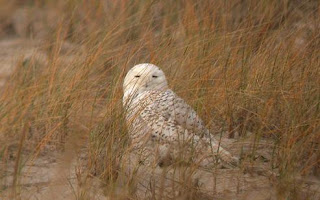These owls are looking for habitat that resembles their Arctic homes. Tundra-like landscapes are perfect for these diurnal hunters, and the beaches in New Jersey that remain relatively undisturbed (I stress the word relatively) by encroaching development may become popular winter destinations for the snowy owl. Unfortunately most barrier islands along the Atlantic this far south have become heavily developed tourist areas, drawing large numbers of residents and visitors during the warmer months of the year. This leaves little habitable space for the birds, who must find places like Island Beach State Park and Sandy Hook National Recreation Area in order to survive.

Photo taken by David La Puma (c) 2004

Birders salivate at the chance to catch a glimpse or a photograph of one of these Arctic breeders. Rodent populations are somewhat unstable, and even in a down year with multiple sightings there is no guarantee any individual birder will be able to relocate the bird. So when there are this many snowy owls around it's considered a "good owl year". Unfortunately it's just the opposite for the birds. It's a bad year for them in terms of prey abundance. They have less food, which in turn means less energy. They need to fly further south than they're used to in order to find suitable habitat. That habitat may include dangerous roads, towers, and utility lines that contribute to bird mortality. Birders and other wildlife enthusiasts may flock to the area of a reported sighting putting even more stress on the birds. This is not to say all bird-watchers and nature lovers are only out to get a glimpse of a snowy owl and will stop at nothing to attain their goal. In fact, for the most part these groups (of which I am proudly apart of) are respectful and careful about how they approach and observe wildlife. As in any other group of people, however, there are a few bad apples. People willing to scare the bird and force it into flight again and again so they can get a closer look or capture a dramatic photograph are certainly around.
Being able to observe and appreciate these marvelous creatures is an important reason why so many people support environmental organizations, but education is an integral part of the process. If a bird seems startled or is changing its own behavior due to that of a person, the person is most likely too close. For some birds this distance can be very small. Chickadees will curiously fly to people to investigate. For some birds, though, the distance can be vast. This is usually the case for raptors like owls. They can see great distances and may notice people approaching from up to a mile (or perhaps even more) away. These birds are already under great stress and the added pressure of humans can spell trouble. Snowies have already died this year in Maryland and if trends continue more will suffer the same fate.
It is certainly possible to appreciate the beauty of nature and the fascinating ecology of wildlife without needlessly disturbing and harming it. Become educated on the animals you are watching, act respectfully, and remain aware of their behavior when trying to approach them.





No comments:
Post a Comment